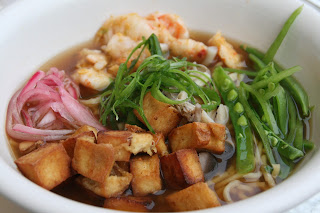Asian Noodles with Shrimp and Vegetables
Why this recipe works: traditional Japanese ramen soup often includes exotic ingredients such as miso(a fermented soybean paste). Here, we use the unlikely combination of smoky bacon, shrimp shells, and chicken broth to mimic the complexity of a traditional ramen broth. We recommend buying shrimp intact, peeling them yourself , and suing the shells to flavor the broth. But if you prefer the convenience of prepeeled shrimp, add an additional strip or two of bacon to the broth to make up for the lack of shells.
Asian Noodles with Shrimp and Vegetables
Ingredients:
4 slices bacon
1 pound large shrimp, peeled and deveined, shells reserved (optional)
6 scallions, white parts halved lengthwise, green parts sliced thin
1 (2 inch) piece fresh ginger, peeled, sliced into ¼ inch rounds, and smashed
3 garlic cloves, peeled and smashed
¼ teaspoon red pepper flakes
8 cups low sodium chicken broth
2 tablespoons toasted sesame oil
2 teaspoons soy sauce
3 (3 ounce) packages ramen noodles, flavoring packets discarded
1 (16 ounce) bag frozen Asian vegetables mix
Procedures:
- cook bacon, shrimp shells (if using), scallion whites, ginger, garlic, and red pepper flakes in large saucepan over medium high heat until browned, about 5 minutes. Stir in broth and bring to boil. Reduce heat to medium and simmer until broth is reduced to about 6 cups, 15 to 20 minutes. Strain broth and return to empty saucepan. Stir in soy sauce, 1 teaspoon sesame oil, and shrimp. Cover and keep warm.
- Meanwhile, bring 4 quarts water to boil in large pot. Add noodles and cook, stirring occasionally, until nearly tender, about 2 minutes. Add vegetables to pot and cook until vegetables are heated through and noodles are completely tender, about 1 minute longer. Drain well, then dividde noodle mixture between 4 large bowls.
- return broth mixture to simmer over medium heat. Stir in remaining sesame oil. Ladle broth mixture over individual bowls of noodles. Top with scallion green. Serve.
Kitchen know how deveining shrimp
In a tasting of cooked shrimp that had a had not been deveined, we found that deveining generally does not make a difference in flavor. (the one exception was in shrimp with especially large, gritty viens.) because the appearance of an especially dark, thick vein can be unsightly, we recommend its removal with a quick slit and tug of a paring knife, even if this step is unlikely to change the flavor of the shrimp. According to our research, this “vein” is the digestive tract, which may contain partially or fully digested food. Sometimes the tract is empty, in which case you won’t quite be able to see it and don’t need to worry about removing it.

No comments:
Post a Comment